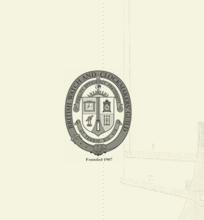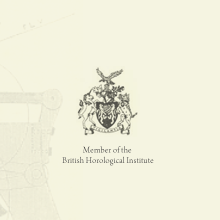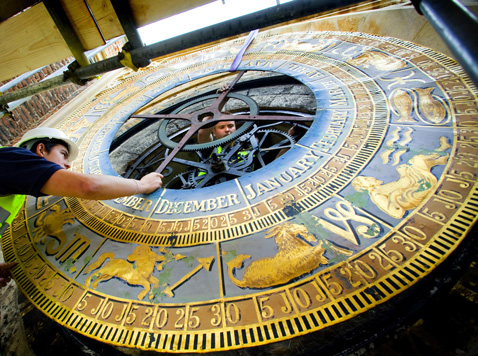






It is uncertain how many clock movements have been installed to drive both the Astronomical Dial and the Base Court Dial, but my research show at least five movements have at one time or another been installed within the tower.
The first mention of an Astronomical dial is in 1528, which is more then likely the workmanship of John Fitzwater who’s family were based in Devon, are thought to be responsible for the Astronomical Clock in Exeter Cathedral, as well as the one situated in Wimbourne Minster.
He is mentioned in 1532 in Henry VIII’s accounts as “Keeper of the Clock” at Hampton Court, but was transferred in 1538 to be Keeper of the Clock at the Palace of Newhall Boreham, Essex.
The clock is not thought to have been very reliable and between 1532 -38 Nicolas Oursian, a French clockmaker was given responsibility. The central spider on which the astronomical workings are based is incised “NO 1540”, however this may only indicated that Oursian managed to make the clock perform correctly and perhaps manufactured a new clock movement for the dials, but the dial or parts of it could still be the workmanship of Fitzwater.
Little is known of what happened during the 1600’s but the records indicate that the Queens Clockmaker William Herbert undertook a complete overhaul and restoration in or around 1711.
It maybe soon after this that the clock movement could have been replaced by one manufactured by Langley Bradley, a good friend of Sir Christopher Wren who had been responsible for the manufacture of the original clock movement in St Paul’s Cathedral.
Again it is reported that this clock was not very successful and by 1831 the Astronomical dial was removed and put in storage and the old clock movement from St. James’s Palace, manufactured by Vulliamy of Pall Mall in 1799 was installed.
In 1879 the Astronomical dial was rediscovered and Gillett and Bland, Croydon, London were asked to reinstate the dial and manufacture a new clock movement. This movement was one of five clocks manufactured by the company, with the others being installed at
Manchester Town Hall, Birmingham Art Gallery, The Royal Courts of Justice and Toronto Town Hall, Canada. Apart from looking after the Palace clock the Cumbria Clock Company (CCC) are not only responsible for the Manchester Town Hall clock, which we have rebuilt over the last few years, but have also undertaken repairs to the Royal Courts of Justice mechanism.
Clock movement by Gillett and Bland 1879.
The unique feature regarding these clocks is the double weighted, remontoir, driving the double three-legged gravity escapement.
This is without doubt the most accurate mechanical escapement ever fitted to turret clocks.
The clock movement was automatically wound by Thwaites and Read in 1960, using their “Monkey-on-a-stick” winding system which after many years of service started to prove unreliable and was replaced by an epicyclic system manufacture and installed by the CCC in 1999.
At the same time the clock movement was dismantled, cleaned and any necessary repairs undertaken.
In 2000 the CCC dismantled all the bell hammers and removed them to their workshops where they were renovated and painted. On their return they were fitted back into position using stainless steel fixings and connected to the clock movement using stainless steel pull wires. At the same time a night silencing system was installed
This is perhaps the most detailed incised slate dial I have ever come across. Not only is the Royal Crest beautifully undertaken, but the spandrels depict birds, fruit and leafs.
The only satisfactory method to undertake the restoration of such a dial is to be very meticulous about making sure that the incisions in the slate are perfectly clean and free of any flaking paint or gold before applying a yellow basecoat. It is very important that this basecoat is given several days to dry before applying the gold leaf, because if the gold is applied before the basecoat is cured the gold will crease and crack reducing its life expectancy.
There must be no masonry work being undertaken around the dial whilst the redecoration is being carried out.
This is without doubt the most important and complex Astronomical dial in the country and based on the Geocentric System where by the earth is at the centre of the universe.
The dial consists of three concentric movable dials, made from copper, the largest of which is 7ft 10in (249cm).
These are surrounded by a chapter ring which is fixed to the stonework indicating the 24 hours in the day.
The dial is read as follows. The long pointer attached to the middle of the dial indicates against the outer dial the month and the day of the month, and the position of the sun in the zodiac. Against the chapter ring attached to the stone bezel the same pointer shows the time of day; for the hours between 6am and 6pm the pointer should be below the horizontal. The small pointer on the inner dial indicates against the second dial the age of the moon. A small arrow painted on the solar dial indicates against the inner dial the time of the moon’s southing (the time at which it will cross the meridian)
From this information the time of high water at London Bridge or anywhere else on the river can be calculated.
As can be seen in the photograph above the paintwork and gilding is starting to fail, but until the dial is removed from the tower it is impossible to tell to what extent.
The dial was overhauled in 1947 and again in the winter of 1959-60 by Thwaites and Reed, Clerkenwell. The dial was repainted in the latter restoration by Gregg and Sons, Clerkenwell.
Originally the outer chapter ring was painted directly onto the stonework, but during the 1959-60 restoration a segmental ring was manufactured and fixed directly onto the stone.
I have a photograph of Mr. John Gregg painting the dials and from that photo it can be clearly seen that the dial was stripped of all paint etc before he started the redecoration of the dials.
I therefore doubt that the dial has any paint on it that dates before 1960.
The gearing behind the dial has been changed several times during its life. With perhaps the central spider, its support frame and the central wrought iron wheel being of any great antiquity and maybe original.
The other wheels in my opinion date from either 1879 when the existing clock movement was installed or from the 1947 and 1959-60 restorations.
The gearing behind the dial is in very good condition and when the CCC undertook the cleaning of the clock movement etc it was fully serviced and inspected.